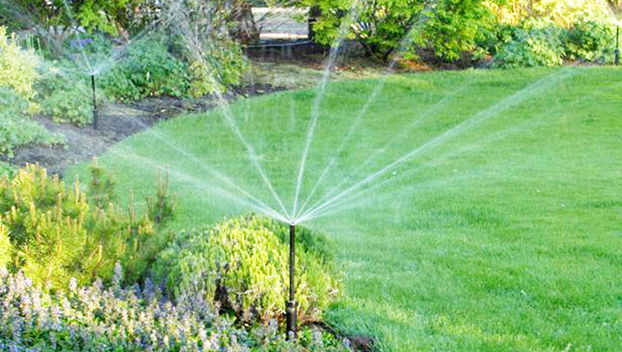MASTER GARDENER — Use these watering techniques for Southeast Texas gardens
Published 12:26 am Thursday, July 7, 2022

- A sprinkler irrigates foundation plantings and the lawn. However, if water is applied excessively, it runs down the curb into the street or provides relief to a neighbor’s lawn. (Courtesy photo)
|
Getting your Trinity Audio player ready...
|
Happy Independence Day everyone! I’m hoping each of you were able to spend time with family, friends and loved ones to celebrate the holiday.
I spoke with my sister recently, who lives in North Alabama, and she asked several questions about watering plants during the summer months. During our conversation, she asked if I could write an article about the best watering technique for keeping lawns and flowering plants hydrated, growing and looking their best without wasting our precious natural resource-water.
So let me begin by saying the way water is applied to our plants is important.
For example, there is absolutely no use in applying water faster than the soil can soak it in when watering a lawn. If water is applied excessively, then water runs down the curb into the street or provides relief to your neighbor’s lawn, at your expense!
Sandy type soils can handle water almost as fast as it can be applied, but the soil in our area of Southeast Texas is clay soil.
Clay soils will soak up water very slowly, often taking days after a heavy rain event. Select the method of application that is the best fit for your soil type. Drip hose or a drip irrigation system is, by far, the most efficient use of water for flower beds and vegetable gardens.
Mulch, mulch, mulch whenever possible! The use of mulch has numerous benefits for trees, shrubs, flower beds and vegetable gardens, since mulch conserves soil moisture, mitigates soil compaction, lowers soil temperature in summer (elevates soil temperature in winter), and helps to reduce weed seed germination.
My preference is to use a 2-to-4-inch layer of organic mulch — such as leaves, rice hulls, pine bark, straw, hay, grass clippings, cardboard and newspaper. Keep an eye on the depth of the mulch material, organic mulch decomposes and will wash away during heavy rainfall.
You’ll need to add more mulch as necessary throughout the seasons to maintain the benefits of using mulch.
There are plant experts who state night-time watering is detrimental to your landscape plants and lawns, espousing plant diseases will develop. In some environmental conditions, I would agree. But there are times when it is acceptable to water your lawn and plants at night.
For example, when daytime temperatures are excessive, 95F or higher I have been known to water during the heat of the day to keep my garden plants and lawn thriving, though there is more evaporative loss of water.
The evaporative loss also cools plants which is often beneficial to the plant!
For water efficiency, water early in the morning or late evening while temperatures are cooler, which means evaporation rates are lower. We all know our summer nighttime temperatures are also hot.
I’m here to let you know, watering at night will not be a significant factor in disease development!
So, the absolute best time to water lawns and plants during the summer is after 8 p.m. and before 8 a.m. If you have an automatic sprinkler system you can set it and forget it, but if you don’t, consider purchasing a mechanical water timer.
They range in cost from $20 to $50 and are well worth the investment since you can set the timer to activate for several hours (2 or 3).
Be mindful of the sprinklers spray pattern to minimize water runoff into the roadway or adjacent property. Move the sprinkler nightly until the entire lawn is watered.
Encourage deep root development by thoroughly watering every time you water the lawn or landscape plantings. By watering thoroughly at 5- to 9-day intervals, ensures deep root penetration and utilization of the available soil moisture.
Often plants wilt during the heat of the day, this doesn’t necessarily mean the soil is dry. If plants remain wilted the following morning, water the area thoroughly, don’t wait until evening as your plants are stressed and will suffer severe damage.
So, let’s get out there a grow ourselves a greener, more beautiful world-one plant at a time! Happy gardening everyone.
John Green is a Certified Texas Master Gardener. If you have gardening questions or need more information, contact the Orange County Master Gardeners Helpline at 409-882-7010 or visit txmg.org/orange, Orange County Texas Master Gardeners Association on Facebook or email extension@co.orange.tx.us.





